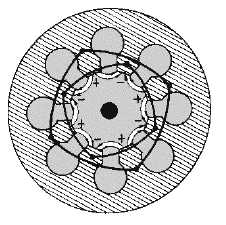2-36
An even number of cavities, usually six or eight, are used and alternate segments are strapped to
ensure that they have identical polarities. The frequency of the pi mode is separated from the frequency of
the other modes by strapping.
For the pi mode, all parts of each strapping ring are at the same potential; but the two rings have
alternately opposing potentials, as shown in figure 2-34. Stray capacitance between the rings adds
capacitive loading to the resonant mode. For other modes, however, a phase difference exists between the
successive segments connected to a given strapping ring which causes current to flow in the straps.
Figure 2-34.—Alternate segments connected by strapping rings.
The straps contain inductance, and an inductive shunt is placed in parallel with the equivalent circuit.
This lowers the inductance and increases the frequency at modes other than the pi mode.
Q-38. What is the primary difference in construction between the basic magnetron and the negative-
resistance magnetron?
Q-39. What starts the oscillations in a negative-resistance magnetron?
Q-40. Why is the negative-resistance magnetron often operated with reduced filament voltage?
Q-41. What type of electron-resonance anode block does not require strapping?
Q-42. Without strapping, the resonant cavities of a hole-and-slot anode are connected in what manner?
Q-43. What are the electrons called that give up energy to the ac field in a magnetron?
COUPLING METHODS.—Energy (rf) can be removed from a magnetron by means of a
COUPLING LOOP. At frequencies lower than 10,000 megahertz, the coupling loop is made by bending
the inner conductor of a coaxial cable into a loop. The loop is then soldered to the end of the outer
conductor so that it projects into the cavity, as shown in figure 2-35A. Locating the loop at the end of the
cavity, as shown in figure 2-35B, causes the magnetron to obtain sufficient pickup at higher frequencies.

